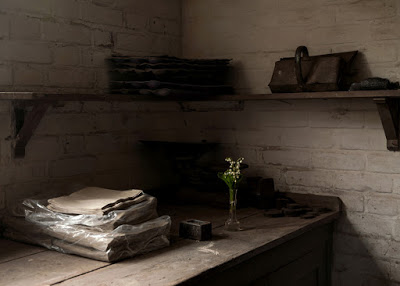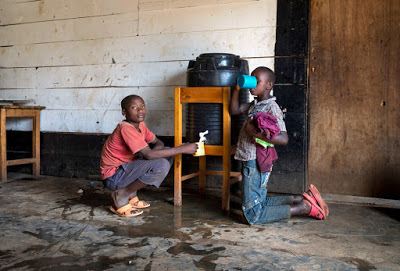Amanda Harman Interview!
 |
| CM15 Solo Show Winner Amanda Harman |
Photolucida: Tell us a little bit about your photography background and how you came to choose photography as your life’s work.
Amanda Harman: I was given a 35mm camera for my 18th birthday, and shortly after that I headed off to do a foundation course in art and design, where I had my first encounter with the darkroom. Like many people, I was captivated by the process while seeing that latent image emerge under the red light. I quickly realized that photography was a medium that really intrigued me and I joined the BA Photography course at West Surrey College of Art and Design.
The rest is a long story… it can sound like a well-planned journey, but it is in fact a meandering path through various jobs and opportunities that are connected by an interest in photography and a desire to work in the field. I have worked on commissions, residencies and projects for galleries and museums and as a freelance photographer for charities and commercial clients. I am also a lecturer and arts project manager and alongside this have continued to make personal projects. In 1999, after a number of years of lecturing, I joined the MA Photography at London College of Communication. It was inspiring and motivating to be back in a learning environment, working alongside other practitioners and being encouraged and challenged by the course and the tutors.
How would you describe the photography scene in the UK – are you in an urban or rural area?
I live in Bristol, which is a city of around 600,000 people in the southwest of England. There is a very vibrant photography scene here, which has really flourished in the last five years with organizations such as IC Visual Lab putting on events and talks with photographers such as David Goldblatt and Alec Soth. Bristol is home of the PhotoBook Bristol festival which hosts an international lineup of stars from the photo-book world. There is a real sense of community around photography in Bristol, which makes it an inspiring place to live at the moment. I also lecture at UWE, where we have a very active research ethos and lots of visiting speakers as part of the programme, so there is much to be inspired by. The opportunity for critique and feedback from peers and colleagues has also proved invaluable in the development of projects. The students keep me on my toes too!
 |
| Lily of the Valley in the Potting Shed, Tyntesfield |
Tell us about your ‘Garden Stories, Hidden Labours‘ series. What led you to find Tyntesfield, the country house you took this imagery in? What inspired you to make this a photo project?
My first encounter with the gardens at Tyntesfield was as a volunteer gardener back in 2012. The previous year I had studied a course in horticulture, out of a love of gardening and the wish to gain a little more botanical knowledge. Once I completed the course, I volunteered to work in the gardens at Tyntesfield, a National Trust property about seven miles from Bristol. I learned a lot from the very experienced gardeners there and at the time this was very much about gardening and not a photography project at all.
I worked in the gardens a day a week for about a year until other work meant I couldn’t keep up my volunteering commitment. Some months later I was drawn back to the gardens, this time with my camera, to start to take photographs. Initially I wanted to explore the ‘behind the scenes’ hard work of the gardeners by making a series of portraits. Whilst I was looking for locations, I started to notice some intriguing ‘accidental’ still lifes of potted plants, tools left lying around, ladders and discarded clothes. I felt photographing these things added to the stories of the people working in the garden, and the more I looked, the more I noticed them; the jacket hanging on one side on the door then the other, the radio moved here and there and the plastic jug always in the same place, plants pruned, wrapped and cut down, fly papers and mouse traps. Over time, more than the portraits, it was the ‘still lifes’ that spoke of the hidden work of the gardeners and the seasonal changes that happened over time.
 |
| Rwandan Orphans Project, Kigali |
It seems like space/environments (both occupied with people and the “ghosts” of people) is of interest to you. Tell us about your trip to Rwanda last year to photograph the schools there.
I traveled to Rwanda in February 2015 with the charity Friends of Rwandan Rugby to photograph their annual coaching tour. FoRR has been working in the country for the past 10 years, building friendships, trust and reconciliation in schools and communities following the 1994 genocide. My brief was to show the work going on in the schools, and the relationships between the Rwandan and British coaches as they shared and developed coaching skills and the fun and enjoyment experienced by the children.
Whilst there I also undertook a personal project, School Portrait Rwanda; making portraits of the school children that I met, and photographing the school buildings and environments that we visited. Visiting different schools each day with the coaches gave me the opportunity to speak with the teachers and to engage with the children who were often watching what was going on. My attention would be caught by children occupying certain environments, or carrying their school bags or books. In some instances the portraits would be made quite quickly, at other times I was able to spend some time with the children, like at the Rwandan Orphans Project in Kigali, where the boys were keen to show me round and spend time being photographed in the classrooms and other spaces. Making portraits when you don’t share a language has been a refreshing experience and makes me think about how much of the process can be unspoken. We mainly engaged with eye contact, a smile and a couple of shared greetings. Both curious and shy, I felt that the young people who stood in front of the camera were very poised and wanted to be seen.
In this project, I am interested in making work that looks forward to Rwanda’s future as embodied in these young people, and in picturing the state schooling infrastructure and other agencies that have been set up since the genocide of 1994. This is the beginning of an ongoing project and I am really fortunate to be able to return later this year to develop the project.
What are some of the challenges you’ve encountered/you are encountering on your creative path? Any relevant advice you can share with others?
One of the challenges is always how to balance working to earn a living (whether that be as a freelance photographer, lecturing or working in other areas) and developing personal projects, then finding time to get the work ‘out in the world’. It’s a difficult balance and it means that there are always ebbs and flows in the personal work. I think the other thing that’s important creatively is to have people around you who can critique your work and help you develop it. I am fortunate, as I have a community of fellow lecturers and photographers around me that are really supportive, so the teaching part is time-consuming, but it also means that I am in a creative environment with access to input from colleagues. This hasn’t always been the case, and I think working away alone can be very difficult. Seeking out like-minded folk and finding interesting talks, exhibitions and events to go to is a way to continue to be inspired and motivated.
What’s another interest of yours, outside of photography (something we might be surprised to learn about you)? Might it be gardening?
I am not sure it would be a complete surprise to learn that I love gardening, and I have an RHS Level 2 certificate in the Principles of Horticulture.
I have also spent a lot of time in rugby clubs over the last 15 years (a surprise even to myself!) and this has led to the inspiration for my next project, on the meeting places for sports and other social pastimes. These clubhouses are again spaces occupied by people, and the “ghosts” of people….
We look forward to having Amanda’s exhibition Garden Stories, Hidden Labours at Blue Sky Gallery here in Portland in April 2016, during Portland Photo Month!




